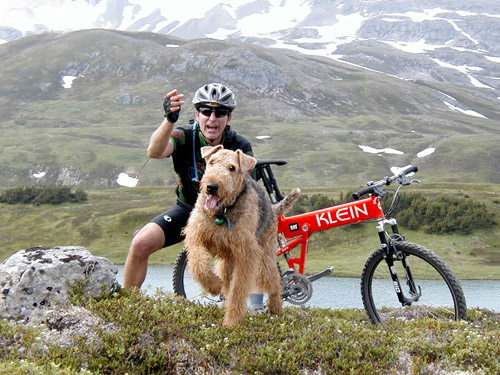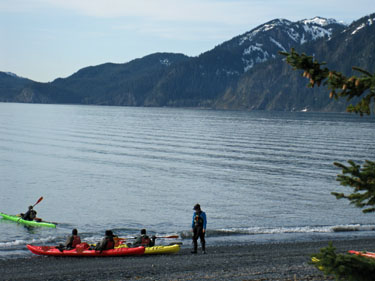Roam
I was thinking about Rufus (aka Tan Man) yesterday during my walk with Lucy. The Happy Wife and I have spent, and continue to spend, considerable time in the company of dogs. I wondered how much I’d spent with Rufus, in terms of the miles we had walked together, including the times he ran/walked and I rode my mountain bike, during the 11.5 years he was with us. I made some conservative estimates.
First, I rounded his age down to 11 years, times 365 days/yr is roughly 4000 days. For a variety of reasons we didn’t walk with Rufus every one of those 4000 days, for instance when we were away on vacation or out of town for work. So again, very conservatively, let’s say 25% of those days we didn’t walk (or me ride) together — 4000 x 0.75 = 3000 days. Then, say the mean distance of the walks was 2 miles. This is harder to estimate, but it seems pretty conservative, because the trails we walk most weekdays at Kincaid Park (near our house) in just the last three years since returning to Alaska are all two miles or longer, and the trails we often walk on the weekends are longer still. Plus, when Rufus was younger, it wasn’t uncommon for us to walk together more than once a day, and being he was a youngin then he would roam a lot, covering more distance than I did on the trail.
So, 3000 x 2 = 6000 miles. According to Google maps, this is about 7% more than the driving distance (via I-80) from Los Angeles to Atlantic City, NJ, and back.
I was surprised by the result. That’s a lot of walking together.
And I wouldn’t trade a single mile of it.
Roam if you want to
Roam around the world
Roam if you want to
Without wings, without wheels
Roam if you want to
Without anything but the love we feel
— B-52s, Roam
Dude?
Transgendered Miss Universe Canada Contestant Takes the Title of Miss Congeniality

I wondered if the transformation was covered by the Canadian Health Care system. Or to reverse the transformation? Once this dudette tires of getting discovered and having his (her?) would-be amours flee the boudoir howling in terror.
In any case, the phenomenon has already been taken up by one of America’s great lyricists:
Pinus Nigra
Removed the remnants of death from the yards yesterday, and into the holes new life went. Three blue spruce, a green spruce, and a lodge pole pine, which we named “Ruff Ball” (aka Tan Man), causing Happy Wife and me to tear-up, again.
Death had come to the four pinus nigra we planted last summer, purchased from Lowes with a 1-year warranty. Shortly after planting the pinus nigra and anthropomorphizing them, we were talking them up to a man at a local nursery when he said, “Wait, did you say pinus nigra?” Why, yes, we did. Uh oh, he said, I’m afraid they love our summers but they won’t survive the winter. But wait, I’d said, the tag on the tree (I produced one from my pocket), look, right here, says they are hearty to twenty five below? Isn’t the cold that kills them, the man said, it’s the dry wind. So, wanting to prove the nursery man wrong we coddled the pinus nigra like newborns, through summer and into fall, and were duly impressed by their continued vitality — they had even grown an inch or two. We watered, fertilized, and mulched, then swaddled them in burlap when the snow flew. “See you in Spring!” we promised them. Death? Not on our watch!
Eleven feet of snow. April. Breakup.
Ever so carefully we unwrapped the burlap to reveal a most grotesque transmogrification. Evergreen had turned Everbrown. Once long straight branches were now freakishly retarded and twisted. The slightest brush against one caused coffee-colored needles to cascade like fallout. “What do you think, a chance they’ll make it?” I asked the Happy Wife. She looked at me as if I’d just told her I bet the 401K on double zero green.
I sawed each pinus nigra off at the ground because Lowes wanted the evidence to fulfill the warranty claim. The root balls were still frozen. I heaved the pinus nigra out of the Honda, wedged them between the bars of one of those big carts intended for lumber, and rolled ’em all to the Returns counter. Lady looks at me sort of puzzled and says, “You’re returning your Christmas trees?” I had to admit they did look like Christmas trees. Visa credit, $600.
Earlier this month I returned to the nursery and spoke to the man who said, “I remember you.” I humbly conceded to the Prescience of Pinus he’d been right. And then I proceeded to buy five trees off his north lot, hardy looking buggers that had wintered well.
Don’t you just want to hug it:

Beep Beep Beep Beep …
Woke to the Beep Beep Beep Beep … of a backhoe on the south side of our house. I guess they (the neighbors) are really going through with it, building a house. Well, some stumps are gone anyway, though we’re a long way from the fondue party on granite counter tops. I don’t doubt the Beep Beep Beep Beep … is an attention getter (with the possible exception of moose, more on this below), intended to alert unwary innocents, so they should not be crushed beneath the ruthless tread of monster wheels, but really, wouldn’t a more tonally pleasant tocsin achieve the same goal? Maybe something consonant with songbirds and Spring, thereby saving us all the teeth-grinding aggravation of that ceaseless $%^&*# sonic tyranny!
Breathe. Just breathe.
Imagine trying to enjoy the daily rag and a cup of coffee with Happy Wife, whilst seated on the infield of a Nascar racetrack during the victory lap. That’s how our morning started. You see, the other side of our house, the north side, is bordered by a moderately busy street.
Anyway, the moose. I should have taken a photograph. A big cow moose was evidently not the least bit unnerved by the backhoe’s assault on the landscape, or the interminable Beep Beep Beep Beep … . She just stood there, munching the leaves ‘n branches of a felled Mayday tree like she was in a moose sanctuary. So much for the incompatibility of wildlife and progress.
Sort of like caribou serenely assembled beneath TAPS:

You thought I was kidding.
Trees
The neighbor felled three large birch trees on the vacant property he owns next to ours. Says he’s going to build a new house, needs to clear the lot. Paved paradise, and put up a parking lot. I watched him cut into those trees with the chainsaw. Hot knife thru butter captures it. Less than ten minutes and all three of them were down, dead. Every one of them must’ve been thirty feet or better, and just beginning to bud, to send out new branches, a further reach for the sky. They lain on the ground overnight, still, the great lumbering giants they were. The stories their rings could tell, all the years they’ve grown up here.
Twenty-three years ago when I first moved to Alaska I moved into a house a few blocks from here. Those birch trees were youngins. Nobody thought to bother ’em back then. And now they’re in the way. Or they were in the way.
There’s nothing the least bit solemn about the buzz of a chainsaw, is there? Seems disrespectful somehow.
Yet, once upon a time our lot needed to be cleared of nuisance too. At least in an effort to replenish, we’ve been replanting trees every year since we returned in ’09. Most have made it, some haven’t. That’s the way things go.
Come Around
Once, during a time of acute grief, I asked a friend how he was doing. His answer stuck with me, “I feel like I’m just taking up space today.” Is there a better definition of purposelessness than that?
Okay, but we are moving on, because it’s what we tell ourselves we must do, move on. Pick yourself up. Get on down the road. New episodes of grief await. Wouldn’t want to miss them! Doesn’t mean we forget, we tell ourselves, no, we dasn’t do that.
And then there are The Perspectivists, “Sure, you’ve suffered a loss, you’re grieving, but human beings all over the world suffer loss every day, many worse than yours, so keep that in mind.”
Oh, right, of course, how could I be so out-of-mind foolish, grief is relative! Grief must be properly assigned to the Great Distribution of all Human Grief. Only then may we see how insignificant our grief really is, “See there, they say, be glad your grief isn’t out in the tail, now that would be significant grief.”
Don’t let it bring you down,
It’s only castles burning
Find someone who’s turning
And you will come around
– Neil Young, After the Gold Rush, 1970
Now, if you don’t mind, Lucy and I are going to take up space somewhere else for a while.
Until we come around.
Friends of the Tan Man
He was born in Wheat Ridge, Colorado on October 24th, 2000. I used to say “whelped” instead of born. I’m not sure why. Born is born, why do we need another word? And boy was he ever born. I was probably driving to New Mexico from Seattle, and although I can’t remember exactly what I was doing that day, I bet it was a bluesky day, one of those days when you wake up and sense something is different in the world, optimism, hope, that kind of thing. I was on collision course with an Airedale. Who knew? Certainly not he or I.
His breeder and her family called him the “Tan Man”, because at birth he was so, well, tan. Airedale puppies are mostly black at birth. He was the shy guy in the litter. When called for dinner his brothers and sisters would run like the wind, but not the Tan Man, he’d hang back and think about the situation first. And if you doubt an Airedale can think, conceptualize a command before acting on it, I urge you to read what Fran Peck has written about the Airedale Terrier, and reconsider.
A good friend of mine drove Tan Man from Wheat Ridge, CO to Taos, NM, where I first met him. Sure enough he was pretty tan, just a little ball of fur and energy snoozing away on a towel in a cardboard box. When he woke up he’d teethe on the first thing he saw, and if that happened to be a human appendage, so be it. For the first six months, as we got to know each other in Santa Fe, my arm looked like I was a heroin junkie. He was a feisty bugger. One day he came roaring out of the bathroom trailing a full roll of toilet paper from his mouth, and I swear as I tried to run him down he TP’d the entire kitchen and dining room in under twelve seconds. We talked about it afterward. I told him what was acceptable behavior and not, and he seemed to understand, so I reloaded the dispenser with a new roll and the very next time he did it (within five minutes) he improved his time to under ten seconds!
Months later when we moved into a new house he got wind of the jack rabbits that would come into the backyard. Once, when my parents were visiting, Tan Man was playing calmly — not a word oft used with Airedales — on the living room carpet, taking apart some toy I’d bought him, one of those toys that’s advertised to provide “hours of fun for your puppy.” Minutes was more like it. Anyway, my dad was in the living room when all of sudden Tan Man shot up and raced to the patio door and went right on through the screen as if it wasn’t there. That’s what my dad said, I’ll never forget the look on his face, half amazed, half concerned, “Why he just kept on going like that screen door wasn’t there!” I found Tan Man about a half mile down the dirt road, putting the fear of dog in a jack rabbit that had disappeared down a hole. Man, could that boy run.
Since he was born and raised at high altitude he was basically a lung on four legs when I got him to Anchorage in 2001. It must’ve been like oxygen doping for him, to move from 7000′ to 400′ above sea level. During our mountain hikes he’d scale a ridge line and run it, paralleling our progress in the valley below, come roaring back down, get a drink from the river, and back up he’d go, hardly winded, like nobody’s business. In ’02 I took him with me on a mountain bike ride, 16 miles up and over Lost Lake, AK. In all the pictures I have of Tan Man from the nearly twelve years we’ve been together, none better capture the sheer alacrity and love of life than this one:

He wasn’t too keen on traveling by car to Cleveland in ’05, but he and his best friend Lucy (our Husky mix) did the three week trip without complaint. Tan Man especially liked the Super 8 hotels (he called them Sleazy 8). One day he slipped his lead coming out of our room and promptly bolted for the lobby area, where I found him standing next to the “All Dogs Must Be On A Leash” sign, brightly wagging his tail while fixed on the desk clerk expecting a treat. And then there was the infamous day near Cleveland, at “The Farm”, a multi-acre property where we frequently went to run off lead, when Tan Man & Lucy just up and disappeared. Sure, they’d roam too far for comfort now and then, but they’d always come back. Always. After two hair-ripping hours of looking for them, a man suddenly pulled up in a car at the police station where I’d walked with an old woman who offered to help me find them, and asked if anybody had lost two dogs. The coincidence of that intersection in time still gives me a chill. We got into his car and raced down a long hill to the place where he’d last seen them. All the while I’m dreading the sight of two dead dogs in the middle of a busy road. Instead, there they were, on the side of the road next to a pickup with a guy named Tim, who had stopped to help when he’d seen them walking together down the center line, “Like they owned the place,” he said. It was the only day in all our years together I thought I’d never see those two again.
In ’09 we were all back in Anchorage again, and everyone was happy. Because coming home does that to you. And not a peep out of Tan Man or Lucy during the entire 5000 mile drive. Not a single complaint. In fact, two better driving companions I can hardly imagine. Guess they knew where they were going is why. And once we were home — me, Nancy, Lucy and Tan Man — we all roamed again, into the mountains, down to the sea, through the parks, in summer and snow, alone and with friends, in good health and not so good health. Because, you see, dogs aren’t complainers, they wag more and bark less. They are loyal, they stick by people, for better or worse, they don’t give up and they ask for little or nothing in return, merely a pet on the head or a scratch behind the ears when they greet you at the door. And they always do.
Yet nothing lasts forever. Not even the Tan Man. Oh that we wish he could. Oh that he had. The undiagnosed lump in his chest did get bigger, but almost imperceptibly. Like most dogs, maybe Airedales especially, he hid his pain, never putting it on display, as if to say, “Look at me, I’m hurting.” Nope. Not the Tan Man, he was as stoic as they come, even demanded to jump (fall really) into the back seat of the Subaru, to go with Lucy on hikes at his favorite park. He wasn’t going very far lately, a few hundred feet maybe, before his leg would give out, and the cataract in his left eye didn’t help matters, but he’d chug along at his own pace. The whole time never issuing a single bleat, not once. Back at home he’d eat a full bowl of food, drain a water bowl and lie down and continue to suck it up.
He was like that, right up to the end, this morning.
Even now, at the kitchen table writing this, when I hear a bark outside, it’s a phantom bark, I know this, but still I look up and listen.
For Rufus, the Tan Man.
It’s not him of course.
There’s just a big fat hole in our hearts now, where he used to be.
God speed, good friend, God speed.



